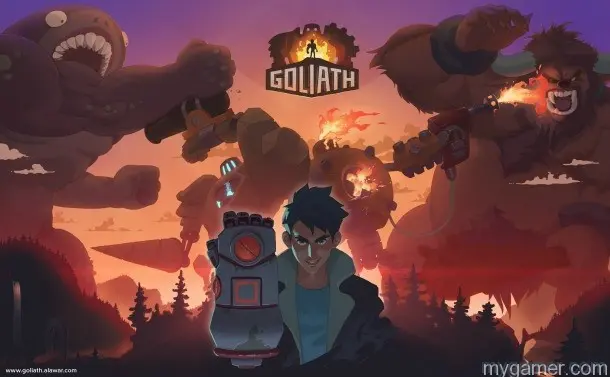Goliath is a survival game, not dissimilar to Don’t Starve in it’s hunting and gathering focus and top-down presentation, that shifts the genre’s focus from having a bit of breakfast to building improvised mechas. The concept alone stirred me with curiosity and genuine excitement. Sadly, due to underwhelming production and presentation elements, Goliath stifled my enthusiasm within its first few hours. It’s a novel concept and solid platform that fell out of the oven way too soon.
Players can build various types of goliaths, each with their own strengths, weaknesses, and special abilities, to help gather resources more quickly and protect themselves from dangerous critters. Goliaths feature a range of stats, can equip various handheld weapons, and be custom built to feature parts from various goliath models. I found myself on a quest to unlock all the machine variants, driven exclusively by the various goliath unlocks.
Despite the variety to be found in the goliath skills, abilities, and styles of play, combat itself feels underwhelming and thin; a clunky hack-and-slash, lacking the optimal interface and controls that make games like Diablo 2 and Van Helsing play with ease. Goliath’s Don’t Starve-style controls just don’t translate well to real-time combat, especially when some special abilities and attacks move your character while being executed. Combat is best summed up as low key and dull, featuring bland character animations, overall sluggish pace, and sound some of the daintiest sound assets I’ve ever heard. Seriously, the audiovisual feedback is atrocious. Landing a hit with your goliath’s giant stone axe or flaming fist sounds like somebody dropped a pencil. Enemy’s reactionary sounds feel like whispers, goliath steps sound like tip toes in leaves, and Gromov’s revolver like a cap gun. As a result, combat lacked the punch it needed to be satisfying.
There’s an early enemy – this tanky, red-eyed bull – that had me completely unnerved. It’s one of the first enemies you encounter and definitely the most frustrating. Its attack set includes a ramming charge ability and a faster head batt, both of which were “unblockable,” interrupted my attacks, and knocked my goliath on its ass. Even my stone goliath’s block ability was made useless. Keeping my distance, circling and rolling out of his path helped keep me in the fight but, still, sneaking in a jab was much more arduous than it should have been, especially given this wasn’t a boss battle. Soon enough, I found herds of them all throughout the fields and even had to face up to three at a single time. Once the trio’s attack patterns tiered, it was virtually impossible to make it out alive. Really, it was was one of the worst moments in gaming I’ve had to endure in a while. Getting knocked down and losing my character’s control to a recovery animation twenty-plus times in a single fight isn’t exactly my idea of a good time.
Despite their size, goliaths move faster and with more fluidity than when your primary character is on foot. Not only is the protagonist nigh useless while on foot, he controls like a forklift – not that I’ve ever driven one. Rather than featuring smooth mouse guided movements, WASD exclusively guides your character, resulting in a rigid, inaccurate system. Furthermore, the way your character is facing is directly tied to his movement, meaning you can’t track your enemies from a still position without moving or attacking in their direction. Using a controller remedied my issue of rigid movement, but still Gromov and his goliaths felt weightless and were janky to control.
Thankfully, resource collection is made easy by allowing your character to absorb nearby drops with the push of a button. While inside a goliath, tasks such as chopping down trees, mining rocks, and more are completed with a single click, saving you the five seconds or so it takes your character to do the same with an axe. Ultimately, I didn’t find any benefit to wandering or collecting resources outside of a goliath.
I did appreciate Goliath’s designs and visual presentation. Despite a few flat or ugly environmental textures, Goliath’s colorful, cartoony aesthetic was decently done and was well-suited to the quirky steampunk, fantasy setting. Many enemy designs were unoriginal: The bull I spoke of earlier, for example, was just a bull with red eyes, a pair of horns, and a rhinoceros horn. His primary attack was charge. A few other stock designs followed their stock concepts, bringing down the production overall, in my opinion.
Despite its mildly inventive premise, Goliath feels surprisingly unremarkable. Between weak sound effects, janky controls, and an overall blemished presentation, I felt like I was playing an Early Access title. Hopefully the devs work to fix and polish what’s already there through patches. Until then, I’d pass up Goliath in the meantime.
